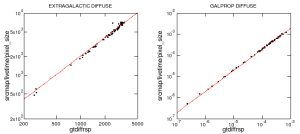Comparison of gtdiffrsp output with gtsrcmaps values
- The diffuse response quantities are proportional, up to an energy-dependent factor (
Unknown macro: {latex}), to the probability densities of a given event for the corresponding source models. If
$s(E)$
Unknown macro: {latex}is the spatial distribution of the diffuse component, then the diffuse response is$\tilde
Unknown macro: {S}(\hat
Unknown macro: {p})$
Unknown macro: {latex}\newcommand
Unknown macro: {phat}{{\hat
Unknown macro: {p}}}
\newcommandUnknown macro: {phatp}{{\hat
^\prime}}
\newcommandUnknown macro: {E}\epsilon
\newcommandUnknown macro: {Ep}\E^\prime
\beginUnknown macro: {eqnarray}d_0(\Ep, \phatp) &= &\int d\phat \tilde
Unknown macro: {S}(\phat) P(\phatp; \E, \phat, t) A(E, \phat, t) D(\Ep; \E, \phat, t)
&= &\int d\phat \tilde(\phat) P(\phatp; \Ep, \phat, t) A(\Ep, \phat, t)
\endHere, $\phat$ and $E$ are true photon direction and energy, $t$ is the arrival time, primes indicate measured quantities, $P$ is the PSF, $A$ is the effective area, and $D$ is the energy dispersion (taken to be a delta function in energy in the second line).
- In gtsrcmaps the spatial distribution is multiplied by the exposure,
Unknown macro: {latex}and convolved with the mean PSF:
$E$
Unknown macro: {latex}\newcommand
Unknown macro: {phat}{{\hat
Unknown macro: {p}}}
\newcommandUnknown macro: {phatp}{{\hat
^\prime}}
\newcommandUnknown macro: {E}\epsilon
\newcommandUnknown macro: {Ep}\E^\prime
\beginUnknown macro: {eqnarray}E(\Ep, \phat) &=& \int dt A(\Ep, \phat, t)
P_Unknown macro: {rm avg}(\phatp; \Ep, \phat) &=& \frac
Unknown macro: {1}Unknown macro: {E(Ep, phat)}\int dt A(\Ep, \phat, t) P(\phatp; \Ep, \phat, t)
d_1(\Ep, \phatp) &=& \int_Unknown macro: {Deltaphatp}\int d\phat E(\Ep, \phat) P_
(\phatp; \Ep, \phat) \tilde
Unknown macro: {S}(\phat)
\end$E$ is the time-integrated exposure and $P_
Unknown macro: {rm avg}$ is the average PSF. The integral over $\phatp$ is over the pixel size ($\Delta\phatp$). For an inertial pointing, $E$ is just the effective area times the livetime $\Delta t$ and we should have
\beginUnknown macro: {equation}d_0 = \frac
Unknown macro: {d_1}Unknown macro: {Delta t Delta phatp}\end
